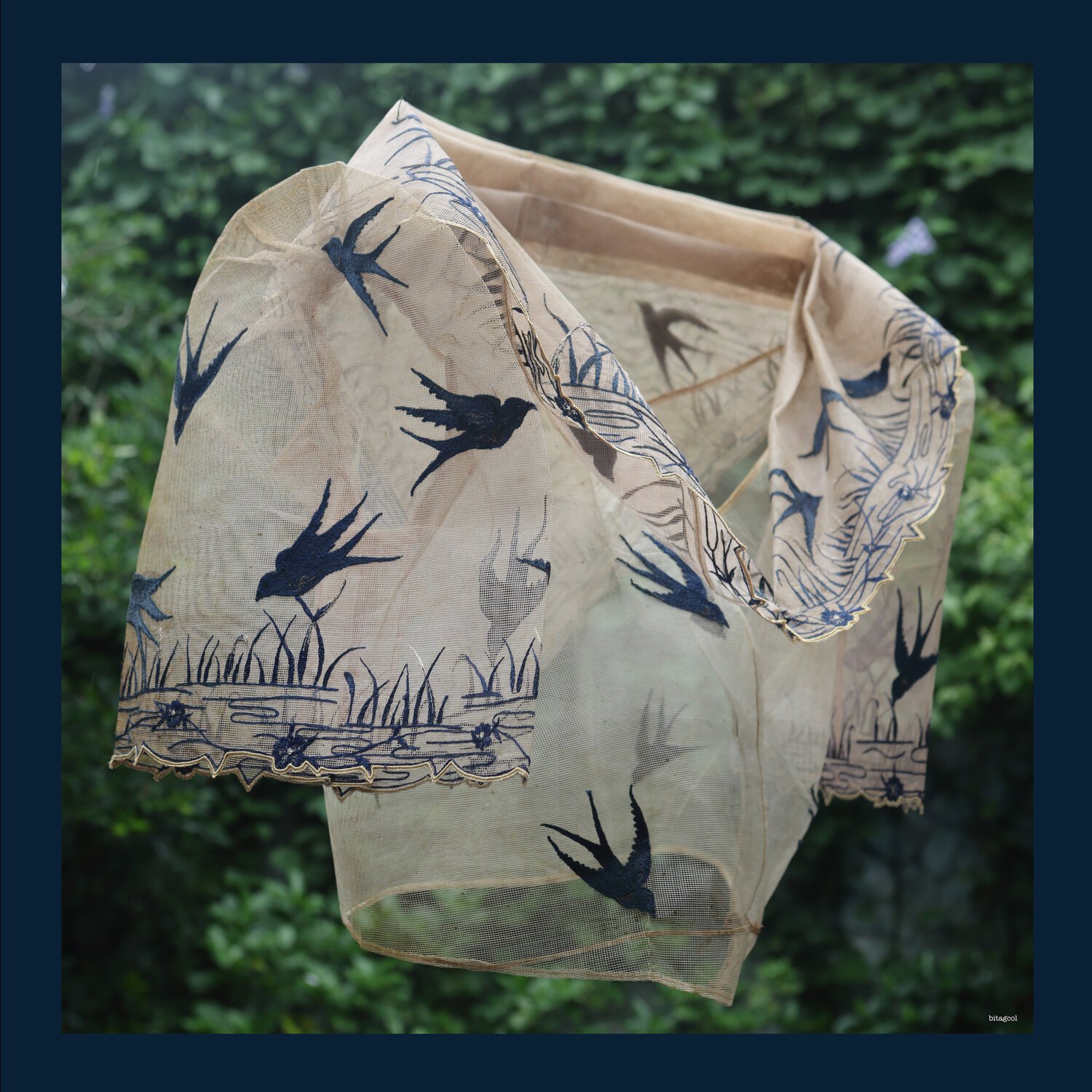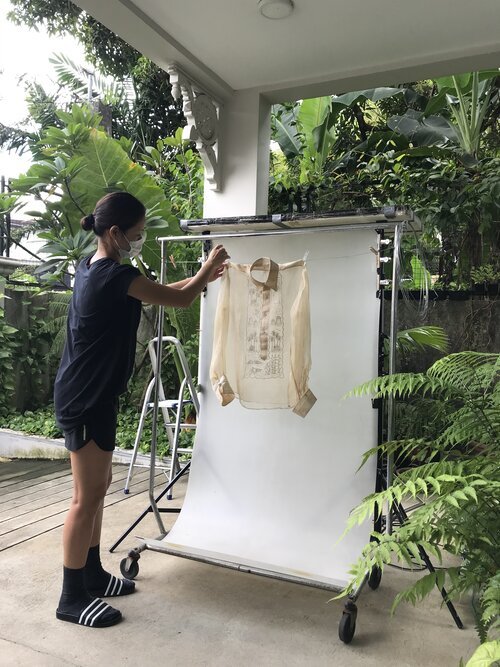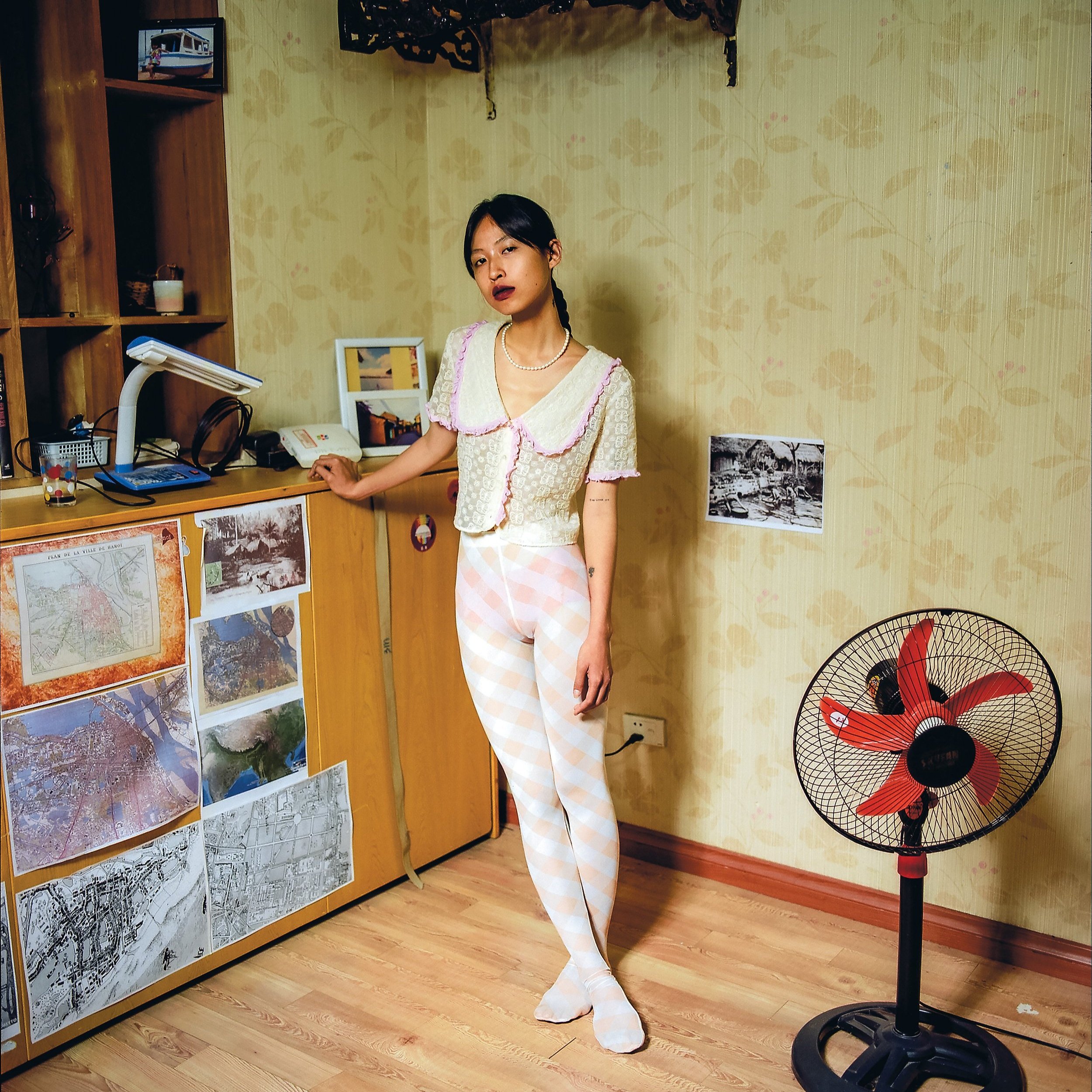Jo Ann Bitagcol: Visually Archiving Filipiniana
Photographing ‘Fashionable Filipinas’
By Daniela Monasterios-Tan
Jo Ann Bitagcol holding a scarf featuring her photograph of terno sleeves. Image courtesy of the artist.
Jo Ann Bitagcol is a fashion and fine art photographer based in Manila whose serendipitous introduction to the industry began when she was scouted as a model at 18. In 2014, Bitagcol was behind the lens archiving jewelry, textiles, and Philippine dresses for the book ‘Fashionable Filipinas: An Evolution of the Philippine National Dress in Photographs 1860-1960’ by Gino Gonzales and Mark Lewis Higgins. Fast forward to today, the photographs of Filipiniana that Bitagcol curates are found on silk scarves and garments, inviting new interactions with historical dress and textiles.
The objects that Bitagcol features prominently are a variety of national Filipino dress such as the terno, the barong, and the pañolito. Filipino national dress shows the way that indegenous culture and Spanish colonial dress imposition interacted with each other, exemplifying the ways culture is assimilated. Many of these garments were originally produced in piña— a fabric made from pineapple fibres- which has a distinct sheerness and stiffness. The terno has also seen itself intertwined in social and political symbolism. After the overthrow of President Ferdinand Marcos in 1986, it fell out of fashion due to its associations with his wife, Imelda Marcos. Through photography, many of which are portrayed lightly floating across our eyes, Bitagcol invites a new audience to tenderly relook at these historical garments and textiles.
In this conversation, Bitagcol speaks to us about her practice, and how she has embraced all the happy accidents that have led to her current body of work.
Camisa of the traje de mestiza. Image courtesy of the artist.
I am so pleased to be able to find out more about your work. I first came across your pieces through the instagram account @fashionable_filipinas, a wonderful visual archive of all things filipiniana. I have also read that you had an exciting introduction to fashion, where you were scouted as a model at 18 and eventually enrolled into Slim’s Fashion and Arts School. Could you tell us more about what made you decide to learn dressmaking?
I think this can be traced to my childhood when I used to make dresses for my dolls and my mom always thought I would become a dressmaker. In school, one of my favourite subjects was home economics where we did basic pattern-making, embroidery and crocheting. I am proud to say I was the best in the class!
Although I began as a model at 18, I eventually was drawn to photography out of curiosity. When I began to print these photographs on silk scarves, opportunities opened up for me to retail them so I decided to enroll at Slim’s Fashion and Arts School to learn the basics of dressmaking.
Photograph of a terno. Image courtesy of the artist.
Photograph of a terno. Image courtesy of the artist.
Could you tell us about your journey into photography and how you became involved in ‘Fashionable Filipinas: An Evolution of the Philippine National Dress in Photographs 1860-1960’?
I began to take up photography while I was trying to expand my modelling portfolio. I wanted to take my own photographs and I decided to take up a black-and-white photography workshop in the University of the Philippines Diliman while modelling. I also sought advice from photographer friends and apprenticed under Lilen Uy, an established fashion photographer in the Philippines. I enjoyed the process and have stayed behind the lens since then. With regard to ‘Fashionable Filipinas’, I have actually worked with both authors at different times. I first worked with Gino Gonzales at fashion shows as a model, and also as a photographer for student’s graduation pieces for Mark Lewis Higgins who owns Slim’s Fashion and Arts School.
How did the project ‘Fashionable Filipinas’ develop your practice as a photographer? Were you already very knowledgeable about the history of Filipiniana dress?
I am so grateful for this book project and it was an honour to be working with the two brilliant writers. ‘Fashionable Filipinas’ expanded my awareness of the beauty of our national costume and culture. This lent my practice a purpose of also passing on important material knowledge about our tradition to the next generation.
“This lent my practice a purpose of also passing on important material knowledge about our tradition to the next generation.”
I find your photographs so intimate, and I love how they really catch the translucency and inner seams of terno and baro. What did you learn about the evolution of design of these garments over the 100 years from a photographer’s perspective?
My appreciation for filipiniana went to a higher level through this project. Everything about it amazes me: the design, the amount of passion poured into details and hand craftsmanship. The variations on details such as the butterfly sleeves, the variations of maria clara, baro, and barong. It is fascinating how Filipinos used to dress up during those times, and these pieces are testament to that.
The debut for your scarves was at a pop-up for Manila Design Collective. Can you tell us more about how they were received by visitors to the pop-up?
The scarves were surprisingly successful! I never expected it to be supported the way it has been by colleagues, fashion and art enthusiasts. Some customers would frame the print and others used them as scarves. That first pop-up proved that Filipinos still respect and love our national costumes, which made me very happy. I am kilig (Tagalog for excited or tickled) each time I get a message of appreciation. Some clients would say, thank you for making these beautiful pieces or please continue what you are doing. These thoughts inspire me to create more collections.
Jo Ann Bitagcol photographing barong for her new series ‘Postura’.
Garment from Bitagcol’s series ‘Postura’. Images courtesy of the artist.
Silk scarf featuring pañolito. Images courtesy of the artist.
Silk scarf featuring pañolito. Images courtesy of the artist.
For your recent pop-up at Katutubo Pop Up/BENCH Market, I see that you have included wearables like tops as well. The images of barong printed on t-shirts have an interesting trompe l’oeil effect. Could you tell us more about this series that you have named ‘Postura’?
This is my latest series featuring vintage barong (long-sleeved shirts) and pañolito (handkerchief) prints. For this set, I used natural light, which creates an interesting x-ray effect. This allows us to see the details of incredible hand embroidery for the pañolito as well as the intricate techniques used to make the barong.
Behind the scenes photographing a barong. Image courtesy of the artist.
Your work seems to me a way to archive these historical objects and give them a new journey. Do you think this is so? How do you see your work developing, and where would you look for more historical objects?
Yes I agree. I give them a new life by digitally printing them on to fabric, making scarves to wear or to frame, and creating ready-to-wear pieces like robes, dresses, and tops. I am opening myself and my work up to new possibilities and looking forward to seeing how my photographs can translate if I collaborate with another creative. I am also excited to see the audience it will capture. As for more historical objects, Gino Gonzales continues to be my source of information and objects to photograph.
T-shirt featuring images of barong and terno. Image courtesy of the artist.
T-shirt featuring images of barong and terno. Image courtesy of the artist.
In your opinion, do you see a shift in how Philippine national dress has been adopted in everyday life? What are your personal memories of national dress growing up?
As a kid, I had this belief that national dress was for old people and used only on special occasions. I would only see filipiniana in grade school during linggo ng wika (National Language Month, celebrated in August). This is why I want my pieces to be flexible, to be worn day or night, for formal or informal occasions. I hope my work can relate to and be worn by both young and old, regardless of gender. This is my interpretation of adapting to time and everyday life.
Thank you so much Jo Ann for your time, and the wonderful photographs! We look forward to seeing how your visual archive will grow.
Jo Ann Bitagcol’s pieces are available for sale via her instagram @bitagcol.






















